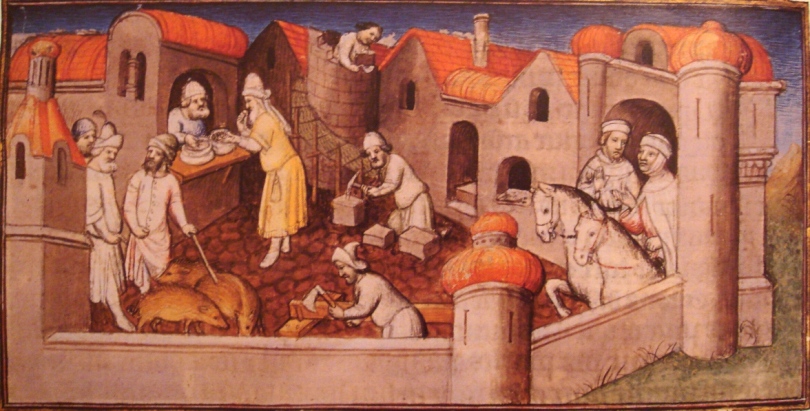In 1254 A.D., the overland journey from the Mediterranean to Mongolia was far flung and dangerous. Many barbarian nations were encountered therein, but the result was a success and a curious adventure.


King Hethum I was the Lord of the Mountains and Coast called Cilicia. Governed by the medieval Kingdom of Armenia, Cilicia ranged from the Taurus Mountains, where Alexander the Great had once crossed into the East, to the northeast corner of the Mediterranean Sea, where Ancient Armenia’s Tigran the Great once jockeyed with the late Roman Republic for supremacy. At its greatest extent, the medieval Armenian Kingdom of Cilicia reached Caesarea and Iconium to the west and Jerusalem to the south.
Coming off a relatively minor golden age in which the Armenian Apostolic Church flourished–especially in the realm of literature–thanks to a few generations of quiet peace in the region, the Armenians found themselves once again in the midst of a clash of wars between East and West. Turkic tribes were invading through Persia and terrorizing the Middle East. Jerusalem had fallen and the Crusades were commenced. The Armenians, who refused to convert to Islam or forsake their ancient heritage, contracted their dominion and resorted to the mountains of the Armenian Highlands and the Taurus Mountain Range.

For 295 years between 1080 A.D. and 1375 A.D., the reigning Armenian kings were able to hold Cilicia and the surrounding regions with successful military offensives to keep their neighbors in check; an array of fortified settlements centered around churches located in highly defensible mountains; and a handful of helpful alliances. Frankish Crusaders, particularly those of the French House of Lusignan, were welcomed and married into the royal line of Hethumid kings in the Armenian House of Lampron, of which King Hethum I belonged. Similarly, the Armenian noble barons and the Crusader princes in the County of Edessa to the east and the Principality of Antioch and Kingdom of Jerusalem to the south all eventually intermingled to integrate their royal dynasties, in a way much akin to many medieval kingdoms that history has seen throughout the world. Thus, a valiant and heroic kingdom arose upon the mighty brow of God’s Holy Land and withstood the mighty tremors that the Devil beat upon it.

However, despite the fancied glory of the Crusades, the true key to the dominion was held far to the east, in a city called Karakorum (modern: Övörkhangai Province, Mongolia), the capital of the Mongol Empire.
The Mongol Empire controlled the whole world east of Byzantium and Europe. Fortunately for the Armenians, they shared a similar interest – to defeat the rising Islamic forces. The Mongols simply wanted to rule the region while the Armenians wanted to put an end to the anti-Christian oppression and terrorism. So, King Hethum I sought to secure an alliance with them by kindling this common goal. His mission was successful.
While on his diplomatic mission to meet Möngke (Mangu) Khan in the capital of Karakorum, Hethum I encountered many of the fanciful beings that his rough contemporaries like Marco Polo and Ibn Battuta came into meeting with. In fact, Hethum I was the king who received Marco Polo in the Armenian port city of Ayas (modern: Adana and arranged for his safe passage up to meet Kublai Khan in what would famously become the start of Marco Polo’s travels.

And so, such were the wonders Hethum had seen during his travels:

A race of people whose women were human and smart but whose husbands were dog-men, hairy and large, who hunted game and brought back food for the women. They coupled in union, producing offspring that, if male looked like dogs, and if female appeared human.
And islands of snow surrounded by colossal walls of ice in a freezing sea that sprouted trees of ivory.
The dog-men were similarly encountered by adventurers like Marco Polo and Carpini and others, but no explanation stands for their being. Historians chalk it up as one of the more common tales of Siberian folklore.

The islands of ivory however are now well known to be the arctic islands off the east coast of Siberia where an abundance of walrus and mammoth tusks can still be commonly found.
When he returned to Cilicia in 1255 A.D., he returned as a king allied with the new, mighty Mongol Empire. The joint Mongol-Armenian alliance would famously win the Siege of Baghdad in 1258 A.D., ending the Islamic Golden Age.
Accounts of observations from King Hethum’s journey have served great import for scholars as well as future travelers. The wonders of the East that have sparkled in the minds of men of the West, though, have been better recorded, more fully, by other, more famous figures like Marco Polo and Ibn Battuta.
Source: The Journey of Het’Um I, King of Little Armenia, To the Court of the Great Khan Mongke, John Andrew Boyle, Central Asiatic Journal, Vol. 9, No. 3 (September 1964), pp. 175-189, Harrassowitz Verlage. https://archive.org/details/Boyle1964Hetum/page/n3/mode/2up
Source: Vahram’s Chronicle of the Armenian Kingdom in Cilicia, During the Time of the Crusades, Vahram; Neumann, Karl Friedrich, University of California Libraries, (1831). https://archive.org/details/vahramschronicle00vahrrich/page/n8/mode/2up
Categories: Medieval
Did not know that the alliance of Armenians and Monguls had such an effect on the siege of Baghdad.
LikeLike